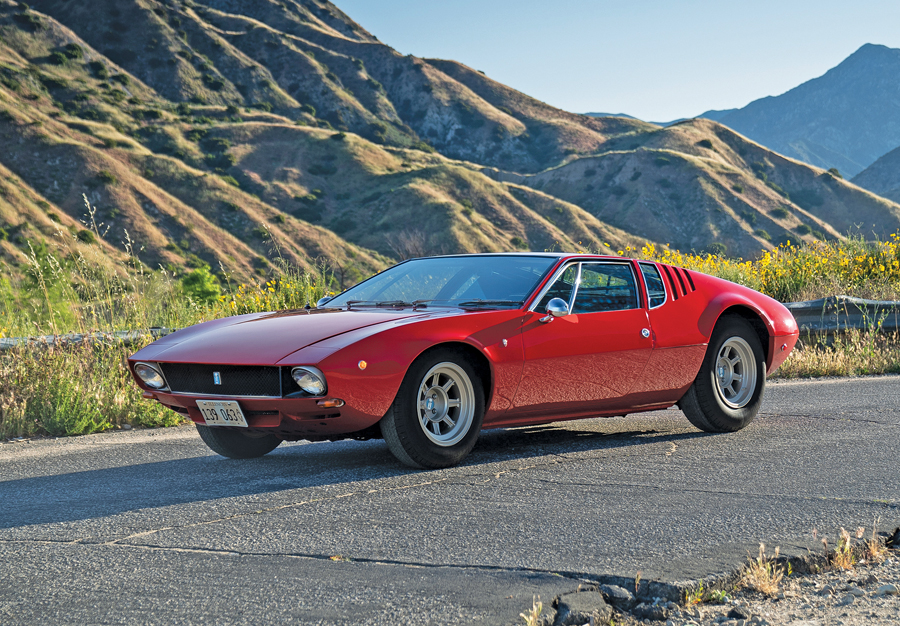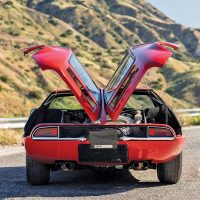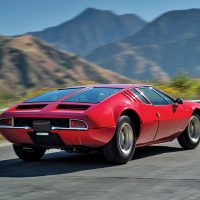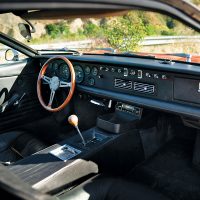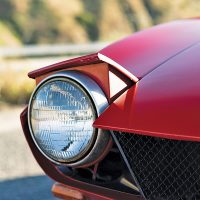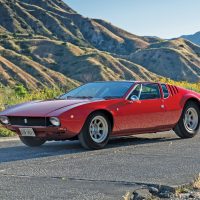- 302-ci Ford V8, ZF 5-speed manual transaxle
- Believed to be one of only 50 built with retractable headlights
- Displays less than 13,000 miles, believed to be original
- Two-owner example; 46 years of first-hand ownership
- Accompanied by original sales invoice, owner’s manual and tool roll
SCM Analysis
Detailing
| Vehicle: | 1969 DeTomaso Mangusta |
| Years Produced: | 1967–71 |
| Number Produced: | 401 |
| Original List Price: | $11,500 |
| SCM Valuation: | $280,000 |
| Distributor Caps: | $15 |
| Chassis Number Location: | Stamping on frame member at right rear corner of engine compartment, data tag in front compartment on bulkhead |
| Engine Number Location: | Intake side of block |
| Club Info: | Mangusta International |
| Website: | http://www.mangustainternational.com |
| Alternatives: | 1967 Iso Grifo GL, 1969 Corvette 427, 1970 Monteverdi Hai 450SS |
| Investment Grade: | C |
This car, Lot 3088, sold for $214,500, including buyer’s premium, at RM Auctions’ Fall Auburn sale held on August 31, 2019, in Auburn, IN.
I have profiled a Mangusta for SCM three times, counting this piece. Looking back, the same or very similar themes keep arising. What defines the characteristics that attract enthusiasts to the elegantly brutal DeTomaso and those that repel them in seemingly equal measure?
The delicate Vallelunga, DeTomaso’s first car, is one of my all-time favorites. It seems to me very much in the character of the OSCA cars that Alejandro de Tomaso raced in the 1950s: a well-balanced, lightweight but potent small-bore sports car that appealed as much aesthetically as dynamically.
But he didn’t sell many of them for a variety of reasons, including some under-development in chassis stiffness. The next move seemed logical: going to a stronger, more dramatic and more powerful car — something that would obviously have greater appeal to the lucrative U.S. market. The Mangusta fit the bill, and with more than seven times the number built, proved the case.
Sibling rivalry
In previous profiles, I’ve made the obvious comparison between the Mangusta and another Italian-American hybrid sports car of the period, the Iso Grifo. The Grifo’s design was also a product of the brilliant mind and hand of Giorgetto Giugiaro. Most would consider the Grifo a more beautiful car, but the visual drama of the Mangusta can be as compelling in its own way.
Today’s marketplace continues its inexorable move towards ever-greater specificity in grading and valuing objects. This past auction cycle has cemented the fact that we are firmly in a buyer’s market. I don’t see that as a bad thing, nor do I think it is a sign that an automotive apocalypse is near. Markets that move in lockstep up or down are seldom sustainable and almost always hide mistakes in valuations. A rising tide that lifts all boats is swell if you’re a sailor, but I would prefer that in our case, each vessel finds its own proper buoyancy.
The Iso Grifo, individually and as a group, has once again pulled away in value from its rarer but ultimately less compelling rival. I think it is largely due to its perceived and real driving characteristics making it a preferable companion for owners who want to drive their cars on a regular basis. Nevertheless, the price differential is now greater than it has been historically. It’s another way in which the desirability of a particular object may prove more important than a larger market.
Drivers of a price
Our subject car appears to be a largely original car with some older refurbishment. It appeared in the catalog photos to remain quite presentable, at least at a distance. It was also stated to have 13,000 miles and had been in the hands of only two owners from new. As such, it possessed a fair number of desirable attributes of value. It also is a rare single-pop-up-headlight example, and although the catalog listed that as a plus, frankly, most people prefer the fixed four-headlight version instead, representing Giugiaro’s original vision. In today’s market, such seemingly small preferences can have a large effect on prices paid.
In addition, while the long original ownership and low miles are strong attributes, the reality that it has had a respray placed it in that strange “not totally preserved, but not freshly restored” limbo that can confuse many collectors.
This does, however, provide me with another “teachable moment” in which I will make the case for cars that fit in the category of “conservato.” These are vehicles which have always been used, maintained and loved as the dynamic objects they were born to be. If the paint fades, you renew it in the original color. If you get a tear on a seat cushion, it is repaired. Nothing is removed, dismantled or replaced that doesn’t need it for a functional purpose. For me that is the highest form of automotive existence possible.
I did not inspect this car in person, so I can’t vouch for the actual state of the interior, which certainly seemed in the photos to need a bit of loving care.
The steering-wheel rim, which seemed to have been refinished, showed a crack on the rim as it attached to the arm on the right side, and the wheel itself was well aged. There was visible overspray on some bright-trim parts, indicating that the repaint might have been a fairly inexpensive, casual one. This makes our subject a “sort of conservato” car. Looked after? Yes. Loved? Perhaps not.
History versus condition
There is a substantial amount of money hunting for cars at the moment. But, as in any healthy buyer’s market, that money is only spent on exactly what meets the would-be buyer’s needs and desires.
This Mangusta sold near where I would have expected it to, if perhaps a bit on the high side. The buyer chose to focus on the history and reported mileage more than on the condition, and that is not a bad point of view. However, the new owner now has the challenge of what to do with the car, as it will obviously need some work. Deciding on what must be addressed will take time.
I also noted that in the SCM Pocket Price Guide, the Mangusta has suffered a markdown in “Investment Grade” from B to C in the seven-year interval. I’m not quite sure that I would give the charismatic Mangusta the same rating as the lightly loved and much more conventional Longchamp.
Ultimately, I still think that the Mangusta can offer many real benefits for an astute collector who wants something a bit different. ♦
(Introductory description courtesy of RM Auctions.)
